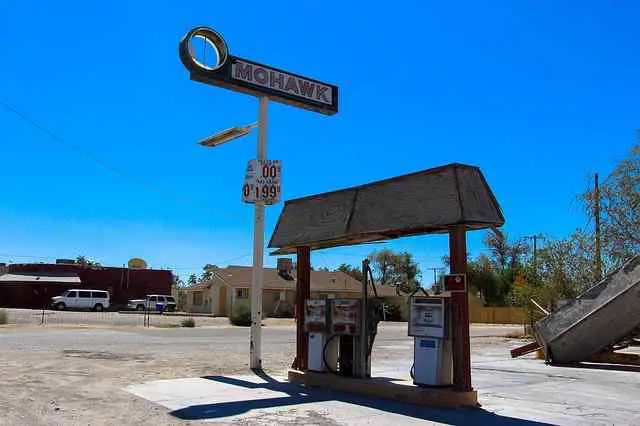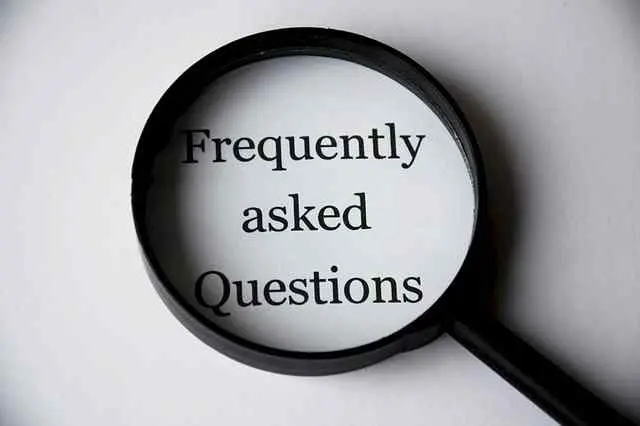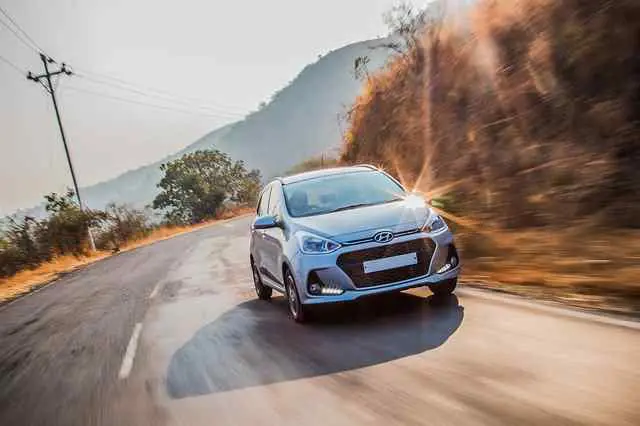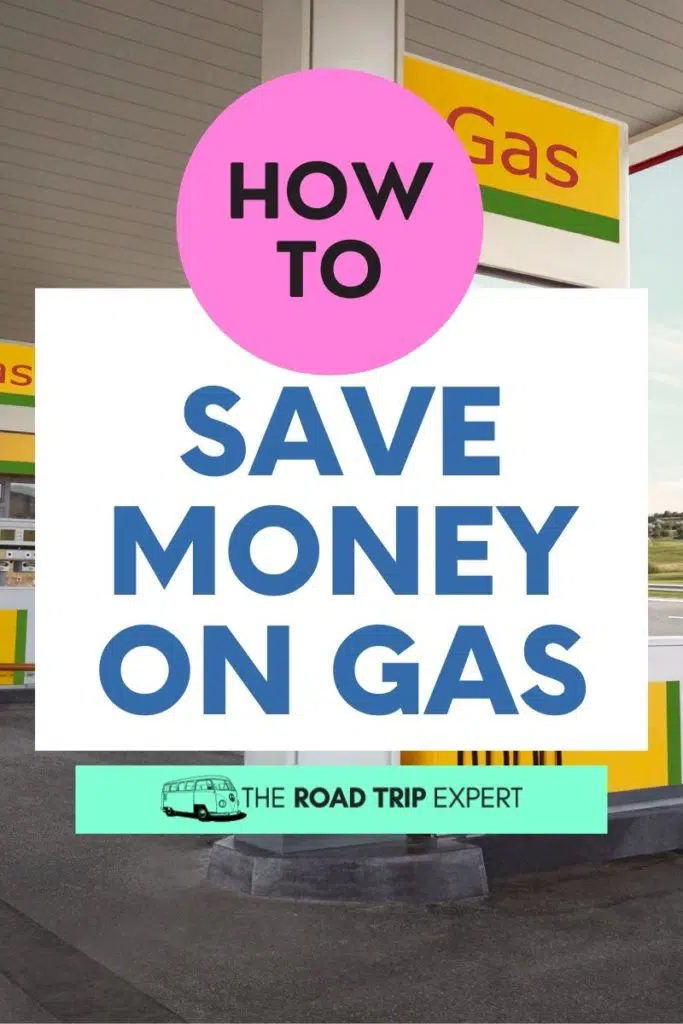In this article, I will discuss how to save money on gas for your car. It includes a list of ways to use less gas while driving and advice on how to pay less for filling up your car with gasoline.
Achieving the best fuel economy is a great way to reduce transport costs. Maximizing gasoline efficiency is easy with this step-by-step guide to minimizing your expenditure.
There is also a list of FAQs in which I answer all of the common questions you need to know in order to save money on gasoline for your vehicle. I’ll be reviewing the best fuel reward programs, gas discounts, and price comparison tools so that you always get the best deal.
The best way to save money on fuel during a road trip involves a combination of paying less at the pump and altering your driving style. There are also some clever in-car habits that can lead to further savings.
Finally, I’ll address winter conditions as well as hot weather, so that you save all year round.
Affiliate Disclosure: Thank you for supporting The Road Trip Expert. When you purchase through links on this site, we may earn an affiliate commission. Please see our advertising disclosure for more details.
How To Save Money On Gas For Your Car

The best way to save money on gas for your car is to avoid aggressive driving, observe the speed limit, and remove rooftop cargo boxes. Each of these behaviors can generate gas cost savings of between 2%-40%. Sensible driving alone can save up to $1.22 per gallon due to increased fuel efficiency. Maintaining your vehicle, reducing weight, and keeping tires properly inflated also lead to improved fuel economy.
You should also avoid inner-city driving, get the cheapest price on a full tank, and accelerate gradually. Other tips include reducing the use of air-con, joining a gas rewards program, and aiming for 55-65mph whilst driving on the highway.
| Gas Saving Tip | Fuel Economy Benefit | Equivalent Gasoline Savings |
| Avoid Aggressive Driving | 10%-40% | $0.31-$1.22/gallon |
| Observe The Speed Limit | 7%-14%* | $0.21-$0.43/gallon |
| Avoid Roof Top Cargo Hauling | 2%-17% | $0.06-$0.52/gallon |
| Correct Engine Tuning | 4% | $0.12/gallon |
| Use Reccomended Motor Oil | 1%-2% | $0.03-$0.06/gallon |
| Keep Tired Properly Inflated | 0.6% | $0.02/gallon |
| Remove Excess Vehicle Weight | 1%/100lbs | $0.03/gallon |
| Avoid Excessive Engine Idling | Time-based | $0.01-$0.02/min (AC off) $0.02-$0.03/min (AC on) |
| Using Cruise Control | Undefined | Likely to save gas |
*In the case of speed limit observation, this is average savings assuming drivers slow down by 5-10mph.
The data for this table was constructed from studies conducted by the U.S Department of Energy Fuel Economy Source. Here is a full list of additional points and advice to save as much money as possible on gasoline. Paying less for gas is a key component so that is covered too!
Accelerate Gradually
Fast acceleration will lead to a higher power output from your engine which uses more gas. Stick to gradual acceleration and avoid heavy braking to save money on gas while driving.
Not driving sensibly can lead to an astounding 10%-40% reduction in gas mileage during inner-city routes and 15-30% on the highway.
Follow The Speed Limit
Vehicles reach their optimal mile per gallon efficiency at different speeds, but going excessively fast is directly correlated to decreasing mileage. Driving at speeds above 70mph leads to significantly lower MPG figures.
Remove Your Roof Top Cargo Box
If you are not currently using your rooftop cargo box, then be sure to remove it from your car. Studies have shown that the increased aerodynamic drag can lead to higher costs. Removing the box can save you up to 20% on fuel during a year of driving!
The benefit to fuel economy has been shown to be between 2%-17%, leading to a gasoline saving of between $0.06-$0.52/gallon.
Ensure Correct Engine Tuning
If your engine is not tuned correctly it can cause excessive consumption of gasoline. Make sure your vehicle is properly maintained and any faults detected during an emissions test are resolved promptly. Fortunately, ensuring you do this can lead to an up to 4% fuel economy benefit!
Use Recommended Motor Oil
Surprisingly, you can achieve a 1%-2% increase in your gas mileage just by ensuring you are using the correct motor oil in your vehicle. Using the correct oil minimizes the friction within your engine which leads to energy savings during its operation.
Check Tire Pressure Regularly
Poorly inflated tires will decrease fuel efficiency due to the extra friction with the road. Check with your mechanic or view your car manual to find out the correct pressure setting for your vehicle.
This is one of the core points on our guide to preparing your car for a road trip.
Keep Vehicle Weight As Low As Possible
Fuel consumption is positively correlated to vehicle weight. Don’t drive around with unused items in the back if they aren’t needed. For each additional 100lbs of weight in your vehicle, you may reduce your vehicle’s miles per gallon by up to 1%.
Take those golf clubs out and store them in the garage!
Avoid Excessive Engine Idling
Avoid keeping the engine running in circumstances where it’s avoidable. This might be whilst sitting in a parking lot, in a traffic jam, or whilst eating a takeaway. Your MPG when stationary is zero!
It only takes a very small amount of fuel to restart your car, so turning the engine off even for a few minutes will save gas.
Check out our guide on how long you can leave a car running to learn more about this.
Use Cruise Control To Your Advantage
Cruise control has been shown to generate savings in excess of 7% due to its ability to help you maintain a continuous speed on the highway. Take advantage of this by setting your car to cruise at between 55-65mph and gain the maximum benefit.
Plan Ahead To Avoid Expensive Gas Stations
If you wait until you are nearly out of gas to fill up, you risk being forced to do so at a more expensive price. If you get the opportunity for a cheaper rate, fill up your vehicle.
You should also plan ahead and not wait until you are low on gas before looking for a cheap gas station. Avoid filing up on the highway or in high-income areas where prices are known to be higher.
Find Optimal Routes To Your Destinations
An app like Waze is great for determining an optimal route. Making sure you are taking the best route to your frequently visited destinations is a great way to save money on gas.
Try to take the route which involves less stop-starting and reduced idling time at traffic lights.
Enable Eco Mode On Your Vehicle
Modern vehicles often have different car modes which involve different gearbox maps to help you increase fuel efficiency. Eco mode assists you in accelerating steadily to save money on gas.
Consider Obtaining A Gas Credit Card
There are a variety of credit cards that offer you cash or points when you purchase fuel. If you have the discipline to pay the balance off monthly this can be a great way to generate savings. Wells Fargo, Citi, and American Express all have great options.
Find Fuel Reward Programmes
Additionally, there are fuel reward programs offering reduced rates. These often involve conditions such as maximums for the number of gallons you can purchase, as well as the maximum discounts. Make sure to read the conditions carefully so you can take full advantage of the offers.
Popular rewards programs include:
- Exxon Mobil Rewards
- TruNow
- Fuel Rewards by Shell
- Kroger Fuel Points
- Pay With Gas Buddy
Use Price Comparison Tools To Save Money
Paying less for gas is one of the best ways to save money on fuel for your car. When you find the opportunity to get a great deal, take advantage by filling your tank full. Apps such as Gas Buddy are great for finding the best prices.
Do Not Purchase Premium Gasoline
Studies have shown that the increased cost of premium gasoline outweighs the minimal gains in miles per gallon. If your aim is to save money on gas, you should avoid purchasing premium gas. Only use premium gas if the vehicle manufacturer has stated it is required for your engine.
Avoid Inner City Driving
Inner-city driving involves a lot of low speeds and stop-starting in your vehicle. If there are good public transport connections consider using those for your next outing. Alternatively, try cycling, walking, or sharing a lift with friends.
Reducing the amount of inner-city driving is a great way to lead to high cumulative savings throughout the year!
Cruise At Steady Speeds On The Highway
Whilst driving on the highway, aim for a speed of between 55-65mph whilst being in the highest gear of your vehicle. This is the most fuel-efficient speed as you’re in the highest gear, at a steady speed, and within the optimal rev range of your engine. When driving faster the increased power output of the engine leads to less efficient fuel consumption per mile driven.
Keep The Windows Up
Having the windows open changes the aerodynamic profile of your car and decreases the fuel efficiency due to an increase in drag. Dropping the windows down for a short period of time is however a good way to quickly cool down the car without air-con.
Consider Carpooling
Whether it’s for your morning commute or a family outing, carpooling is an excellent way to reduce gas costs. If it means cramming more people in the car just make sure you have some awesome tunes to make it interesting!
Don’t Spend Time Searching For The Perfect Parking
Driving around inner-city areas searching for parking can use up a lot of gas. Consider parking further away and either walking or using public transport to get to your final destination.
This tip is listed in our favorite ways to save money on car parking.
Reduce AC Use
The use of air-con can increase fuel consumption by up to a whopping 8-10%! Turning it off is a great way to save fuel. If you need to cool the car down try opening the window to let a lot of fresh air in, then closing it again to reduce drag.
Drive Fuel-Efficient Vehicles
If gas costs represent a serious amount of your yearly expenditure, you could consider buying a more fuel-efficient car. Cars with smaller engines can deliver superior cost savings. A Skoda Superb Estate, for example, achieves more than double the MPG than a Ford F150.
Hybrid or electric vehicles offer great savings, so you could consider one of those too.
If gas costs $3.00 per gallon, and you drive 20,000 miles per year, this would equate to $1000 in savings by driving a 20mpg vehicle instead of a 30mpg car.
Drive Less Often
When you need to run errands, try to batch them all together in one trip to avoid multiple outings in your vehicle. Make a to-do list at the start of the week and look for opportunities to save time as well as money by grouping your tasks together.
Working from home is an option you could discuss with your employer which would save you time as well as money on your commute.
Skip Driving To Be Healthier
Walking or cycling to your destination not only helps to save your waistline but is great for reducing gasoline expenditure too! Short trips are less fuel-efficient due to frequent inner-city routes and the vehicle engine being at a sub-optimal temperature. It takes a while for your car to warm up, so short trips can be especially detrimental to efficiency. Mix in a few walks to work, or cycle to your next social event!
How To Save Money On Gas On A Long Road Trip

- Accelerate gradually
- Don’t fill up on the highway
- Use a price comparison tool to find the cheapest gas stations
- Avoid carrying excessive weight
- Prepare your car using a road trip checklist
- Use a road trip planning app to find the optimal route
- Hire a fuel efficient car instead
- Use a gas rewards app or credit card
We hope these tips were useful. There are many more just like it included in our post on how to estimate road trip costs.
Save Money On Gas FAQs

How do long distance drivers save gas?
Long-distance drivers save gas by driving on the highway at a consistent speed of 55-65mph whilst using cruise control. They keep the windows closed to reduce drag and reduce the weight of their vehicle, also ensuring their tires are correctly inflated. It’s possible to save up to 20% on fuel during a year by avoiding the use of a roof-top box. This leads to greater cost savings and fuel economy.
How do I get the best gas mileage on the highway?
To get the best gas mileage on the highway you should aim to drive at the most efficient speed which is between 55-65mph. This will achieve the best fuel economy and driving faster leads to a rapid increase in gasoline consumption. Studies have shown that 40% more fuel is consumed while driving at 85mph than at 70mph.
Does driving slower save gas?
Driving slower does save gas due to the reduction in aerodynamic drag and the operation of the engine at its optimal fuel efficiency speed. Studies conducted by the AA showed up to 25% fuel savings by reducing speed from 80mph to 70mph. Reducing your speed by 5-10mph can benefit fuel economy by 7%-14%. It is also reported that each 5mph you drive over 50mph is equivalent to paying an additional $0.21 per gallon of gas due to reduced fuel economy.
Does premium gas give better mileage?
Studies have shown that the increased cost of premium gas does not give sufficiently better mileage to provide a superior fuel economy. Therefore, premium gas does not give better mileage. Premium gas has a higher octane rating which releases more energy when ignited, but the increase in price far outweighs the marginal increase in miles per gallon achieved.
Which gear is most fuel efficient?
All engines reach their optimal fuel economy at different speeds. All cars are designed to operate at the best fuel efficiency whilst being in the highest gear. The best miles per gallon will be achieved whilst in the highest gear traveling at between 50mph-65mph. Driving at low speeds in a low gear is the least fuel-efficient driving situation.
What is the best speed for gas mileage?
The best speed for gas mileage is approximately 50mph-65mph which cruising in the highest gear of the vehicle. The best fuel economy will be achieved by driving at a constant speed in the highest gear of the vehicle. Driving at higher speeds than 65mph can lead to a rapid reduction in fuel economy. Driving at 85mph leads to 40% higher fuel consumption than at 70mph.
Does accelerating quickly save fuel?
Accelerating quickly does not save fuel. This is because you will be operating your engine pas its level of peak torque at which point the fuel consumption per unit of power output decreases. This leads to the use of more fuel when accelerating a vehicle up to a certain speed.
Does cruise control save gas?
Cruise control will help you save gas due to its ability to maintain constant highway speed. Studies have shown potential savings of 7%-14% due to the removal of driver-induced changes in acceleration and deceleration.
Does gas burn faster after half tank?
Gas does not burn faster after half a tank. The reduced weight of the vehicle actually leads to a slightly better fuel economy. The sensor on your vehicle that displays your tank’s gas level is designed to go down faster during the second half of your tank to encourage owners to fill up their vehicle and avoid running out of gas.
Does driving fast waste more gas?
Driving fast does waste more gas due to the increased energy requirement from the engine to combat the aerodynamic drag whilst maintaining a higher speed. It’s safe to assume each 5mph you drive at in excess of 50mph will equate to paying an additional $0.21 per gallon of gas. Optimal fuel-efficiency is reached at around 50mph due to the engine operating at low revs in high gear.
What is the formula to calculate fuel consumption?
The formula to calculate fuel consumption is as follows: Take the total mileage driven and divide it by the number of gallons of fuel consumed during the trip. This number is the mile per gallon of the vehicle. For example, driving 900 miles and consuming 30 gallons of fuel would lead to a calculation of 30 miles per gallon.
Do you burn less gas from a full tank?
You will burn slightly more gas from a full tank due to the increased weight of your vehicle. The average gallon of fuel weighs 6 pounds. Each additional 100lbs of weight has been shown to reduce fuel economy by 1%. This means that a full tank would burn approximately 1% more gas than a tank with 17 gallons less fuel.
Does turning on and off your car waste gas?
It takes approximately the same amount of gas to turn a car on as the engine uses whilst idling for a 10 second period. This means that turning a car on and off does not waste gas if you are doing it to avoid excessive engine idling time. Turning the car off and then restarting the ignition actually saves gas if you are doing it as an alternative to leaving the engine running extensively.
Save Money On Gas In Cold Weather

The fuel economy of your vehicle can be reduced significantly due to winter weather and cold conditions. Here we briefly outline what you can do to maximize your fuel economy during the winter when there are cold weather conditions.
Inner city driving and continual heating of the cabin are the biggest culprits.
Reasons Why Fuel Economy Is Lower In Cold Weather
- Increased engine and transmission friction
- Increased time for your engine to reach its most fuel-efficient temperature
- Additional power use from heating your vehicle interior
- Cold weather can lead to reduced tire pressure, which increases rolling resistance.
- Idling your vehicle prior to departure to “warm it up”
- Cold air leads to increased aerodynamic drag on your car
- Decreased battery performance leading to increased consumption to maintain charge
- Lower-grade winter gasoline can lead to inferior fuel economy
How To Improve Fuel Economy In Cold Weather
- Park your vehicle inside your garage, to maintain a higher starting temperature
- Try to combine errands so that you are driving fewer shorter trips whilst the engine is cold.
- Wear a coat instead of excessively heating the cabin
- Do not idle the car for excessive periods of time before departing
- Maintain the correct tire pressure with frequent checks
- Check you are using the correct motor oil for cold weather driving
- Reduce drag by avoiding the use of rooftop boxes and other add-ons
How To Improve Fuel Economy In Hot Weather

Due to the ability of your engine to reach its optimal temperature quicker, hot weather can actually lead to increased fuel economy. The biggest culprit to reduced mileage per gallon is unsurprisingly the use of air conditioning. Opening the windows can also increase drag, so you need to find a balance between staying comfortable and managing fuel efficiency.
- Whilst at low speeds, open the windows instead of using the AC.
- On the highway, use the AC. Opening the windows would create too much drag
- Avoid excessive use of the air conditioning.
- Use a car sunshade or park the vehicle in the shade to avoid creating excessive cabin temperatures.
- Do not sit in your car with the engine on prior to departure. Idling uses a lot of fuel.
Conclusion
We hope this guide has given you a variety of tips and tricks you can find useful. As you can see saving money is a combination of altering your driving style and reducing the cost at the pump.
We’ve got other guides on this site such as how to save money on a road trip, which you may find useful.
If you enjoyed this article, please consider leaving a comment or sharing this article, it really helps us out!
Disclosure: Some of the links in this article may be affiliate links. This means I earn a commission if you make a qualifying purchase, but this is at no additional cost to you. Thank you for supporting The Road Trip Expert.

